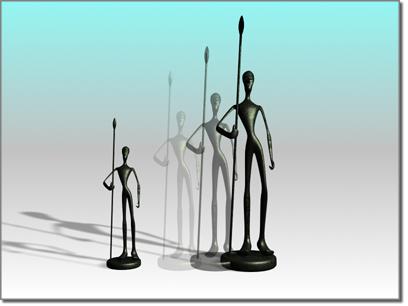

Shift-scale creates a clone of a different size.
Cloning objects while scaling them can produce a variety of nested objects and arrays, depending on the center you choose.
To clone with Shift-Scale:
 Click a Scale button on the Main toolbar.
Click a Scale button on the Main toolbar.
Choose a coordinate system, axis constraint, and transform center.
Make the selection you want to clone.
Hold down SHIFT and drag to scale the selection.
Use the Clone Options dialog to choose the number of clones you want to make and whether you want them to be copies, instances, or references.
Transform settings determine how gmax distributes clones of a selection during Shift-Scale. In all scaling operations, the transform center acts as the center of scaling:
When clone objects decrease in size, they shrink toward the transform center.
When clone objects increase in size, they expand away from the transform center.
The distance between cloned objects is scaled like the clones themselves, based on the initial distance from the original to the first clone. The spacing increases or decreases proportionately with respect to the transform center.
When the selection center is used as the transform center for a single object, scaling occurs symmetrically around that center, producing nested copies.
As you scale in toward the center, smaller and smaller copies are created.
In the other direction, the original object is enclosed by increasingly larger copies.
Variations are possible, depending on the type of scale and axis limitations. For example, you can scale a flat box into a progressively stepped pyramid by using Squash and cloning inward on the Z axis.
For Shift-Scale, any center other than the local pivot has the effect of creating an array of progressively scaled objects. Again, objects scale down in size toward the center, while increasing in size further away. However, this effect is limited by the particular scale option and the axis constraints, as discussed next.
Uniform Scale is unaffected by axis constraints, which are set with the Restrict To buttons or right-click menu. Copies are always arrayed in or out from the center of the current coordinate system.
For Non-Uniform Scale and Squash, scaling occurs only along the axis or axes set with the Restrict To buttons.